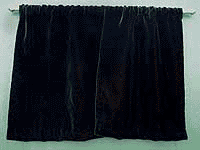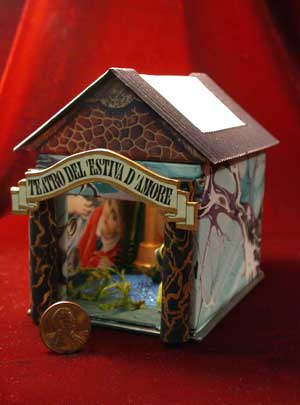 |
 |
|
Artist's Statement
This body of work is a natural progression from my earlier Secret Works series of shrouded and lidded boxed assemblages (exhibited in 1999). I wanted to continue and improve on that intimate experience for the viewer. Thus, the idea of small “theaters” arose. Theaters provided a stage on which visual drama could be composed. They also draw the viewer inside, not only due to their miniature size, but by the idea that drama is taking place within. To some extent the subject matter is narrative, but to a greater extent the content remains open to individual interpretation (which I encourage). The installation I have designed for this series encourages an intimate, individual, and interactive viewing experience that draws the viewer into the “play” to experience and interpret it. Constructed from modular panels to be configured as space dictates, irregularly, or in the round, the dimly lit installation calls to mind the experience of attending the theater. Each display is twice covered, first by a velvet curtain which is drawn aside, then by a miniature scale model door which is opened. Upon opening the door, the viewer is greeted by the lighted display of a single “theater” displayed against black for maximum impact. The anticipation of viewing the work and interaction required to do this, becomes an important part of the experience. The miniature scale of the work in relation to the viewer’s size (whether child or adult) gives the viewer a sense of empowerment while looking inside this tiny world--much the way a child experiences a sense of power when playing with small scaled toys. Empowerment and interaction of the viewer is an essential element of this series. Because the act of viewing this work requires participation, the viewer feels more ready to interact with the work. The 3-D miniature scaled assemblages have a second component, which is 2-D and greatly enlarged in scale. When the 3-D assemblages are completed, I use a digital camera with a macro close-up lens and photograph the interiors of the work. I then enlarge and print the photos, and also upload them to an online website devoted to viewing the 2-D enlargements of the 3-D miniature works. In using the camera to translate the pieces into 2-D illusions, I became much more aware of the shifting compositions within the pieces. Because the camera sees differently than the naked eye, and can only take in one perspective, that of the lens, the dramas become fixed formal compositions of light, color and shape. With this second 2-D enlarged component, the scale shifts drastically and becomes ambiguous for the viewer who is no longer given an intimate and empowering experience. Now the viewer relates in the expected way most art is shown--without drama, or interaction, and at a distance. With the existence of both formats, this body of work plays with the issues of scale, intimacy, and empowerment within our process of looking at art. Subject matter for my theaters comes as a result of my ongoing inner dialog, and responds directly to personal thoughts, ideas or current issues I feel a need to address. CONTACT |
 |